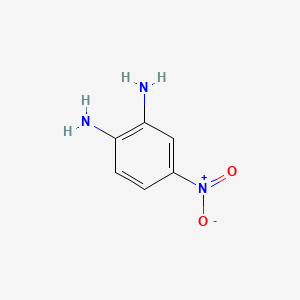



1. 1,2-diamino-4-nitrobenzene
2. 4-nitro-1,2-phenylenediamine
1. 99-56-9
2. 4-nitrobenzene-1,2-diamine
3. 4-nitro-1,2-phenylenediamine
4. 1,2-diamino-4-nitrobenzene
5. 2-amino-4-nitroaniline
6. 3,4-diaminonitrobenzene
7. 4-nitro-1,2-benzenediamine
8. 4-nitro-1,2-diaminobenzene
9. P-nitro-o-phenylenediamine
10. 1,2-benzenediamine, 4-nitro-
11. 4-nitrophenylenediamine
12. 4-nopd
13. 4-nop
14. 4-n-o-pda
15. Nci-c03941
16. 4-no
17. 4ndb
18. 4-nitro-o-phenylene-diamine
19. O-phenylenediamine, 4-nitro-
20. Nitro-o-phenylenediamine
21. Nsc 5378
22. C.i. 76020
23. 4-nitro-1,2-fenylendiamin
24. P-nitro-o-phenylendiamine
25. 5a9ax7y0tt
26. Chebi:67116
27. Nsc-5378
28. Dsstox_cid_958
29. Dsstox_rid_75886
30. Dsstox_gsid_20958
31. Cas-99-56-9
32. 4-nitro-para-phenylenediamine
33. Ccris 451
34. Hsdb 2895
35. Einecs 202-766-3
36. 4-nitro-1,2-fenylendiamin [czech]
37. Mfcd00007724
38. Unii-5a9ax7y0tt
39. Brn 0608106
40. Ci 76020
41. Ai3-52605
42. 4-nitrobenzene-1
43. 2-amino-5-nitroaniline
44. 4-nitrophenylene Diamine
45. 3,4-diamino-nitrobenzene
46. Wln: Zr Bz Dnw
47. 4-nitro-o-phenylene Diamine
48. Schembl78293
49. 4-13-00-00075 (beilstein Handbook Reference)
50. 1,2-benzenediamine,4-nitro-
51. 4-nitro 1,2-phenylenediamine
52. 4-nitro-1,2-diamino-benzene
53. 4-nitro-ortho-phenylenediamine
54. 4-nitro-benzene-1,2-diamine
55. Chembl433721
56. 4-nitro 1,2-phenylene Diamine
57. Dtxsid9020958
58. (2-amino-5-nitro-phenyl)-amine
59. Nsc5378
60. 4-nitro-o-phenylenediamine, 98%
61. Act07448
62. Albb-021305
63. Zinc3860878
64. Tox21_202313
65. Tox21_302811
66. Bbl016368
67. Stk317795
68. Akos000119818
69. Ac-2759
70. Ccg-325544
71. Cs-w007627
72. Gs-3013
73. 4-nitro-o-phenylenediamine [mi]
74. Ncgc00091593-01
75. Ncgc00091593-02
76. Ncgc00091593-03
77. Ncgc00256320-01
78. Ncgc00259862-01
79. 4-nitro-o-phenylenediamine [inci]
80. 1,2-diamino-4-nitrobenzene [iarc]
81. Db-028981
82. 4-nitro-o-phenylenediamine [who-dd]
83. D0103
84. Ft-0614201
85. O-phenylenediamine, 4-nitro- [hsdb]
86. C19384
87. D77683
88. Q5649571
89. W-100032
90. 4-nitrobenzene-1,2-diamine;1,2-diamino-4-nitrobenzene
91. F0001-2335
92. Z1245635744
93. 58833-52-6
| Molecular Weight | 153.14 g/mol |
|---|---|
| Molecular Formula | C6H7N3O2 |
| XLogP3 | 0.9 |
| Hydrogen Bond Donor Count | 2 |
| Hydrogen Bond Acceptor Count | 4 |
| Rotatable Bond Count | 0 |
| Exact Mass | 153.053826475 g/mol |
| Monoisotopic Mass | 153.053826475 g/mol |
| Topological Polar Surface Area | 97.9 Ų |
| Heavy Atom Count | 11 |
| Formal Charge | 0 |
| Complexity | 156 |
| Isotope Atom Count | 0 |
| Defined Atom Stereocenter Count | 0 |
| Undefined Atom Stereocenter Count | 0 |
| Defined Bond Stereocenter Count | 0 |
| Undefined Bond Stereocenter Count | 0 |
| Covalently Bonded Unit Count | 1 |
Carcinogens
Substances that increase the risk of NEOPLASMS in humans or animals. Both genotoxic chemicals, which affect DNA directly, and nongenotoxic chemicals, which induce neoplasms by other mechanism, are included. (See all compounds classified as Carcinogens.)
Indicators and Reagents
Substances used for the detection, identification, analysis, etc. of chemical, biological, or pathologic processes or conditions. Indicators are substances that change in physical appearance, e.g., color, at or approaching the endpoint of a chemical titration, e.g., on the passage between acidity and alkalinity. Reagents are substances used for the detection or determination of another substance by chemical or microscopical means, especially analysis. Types of reagents are precipitants, solvents, oxidizers, reducers, fluxes, and colorimetric reagents. (From Grant and Hackh's Chemical Dictionary, 5th ed, p301, p499) (See all compounds classified as Indicators and Reagents.)
4-Nitro-o-phenylenediamine (NOP) is a powerful direct-acting mutagen which demonstrates significant enhancement in mutagenicity when exposed to plant enzymatic systems. Evidence implicating the involvement of peroxidactic oxidation in NOP activation has been obtained from plant-cell suspension and isolated enzyme experiments. Using selected cytochrome P450 and peroxidase enzyme inhibitors in conjunction with Salmonella typhimurium strain TA98 and intact plant-cell activating systems as well as isolated horseradish peroxidase enzyme /the authors/ have further investigated NOP activation by plant systems. The activation of NOP by both plant cells and by horseradish peroxidase was suppressed by the P450 inhibitors methimazole and (+)-catechin and by the peroxidase inhibitors diethyldithiocarbamate and potassium cyanide, but was not suppressed by the P450 inhibitors metyrapone and 7,8-benzoflavone. In addition, peroxidase enzymatic activity was measured and found to be inhibited by methimazole, diethyldithiocarbamate and potassium cyanide but not by (+)-catechin. The data strongly support the involvement of exogenous peroxidase in the plant activation of NOP, but point to a complex metabolic system that requires multistep processing before full mutagenic potential of the plant-activated component of NOP is expressed.
PMID:7513796 Wilson L et al; Mutat Res 307 (1): 185-92 (1994)